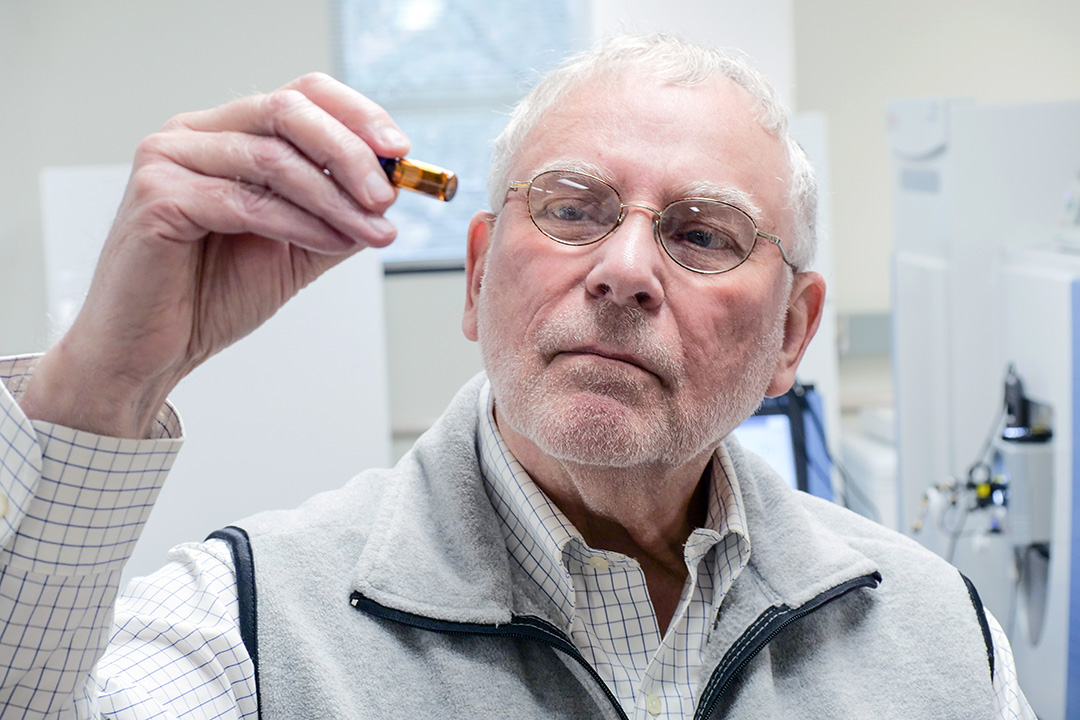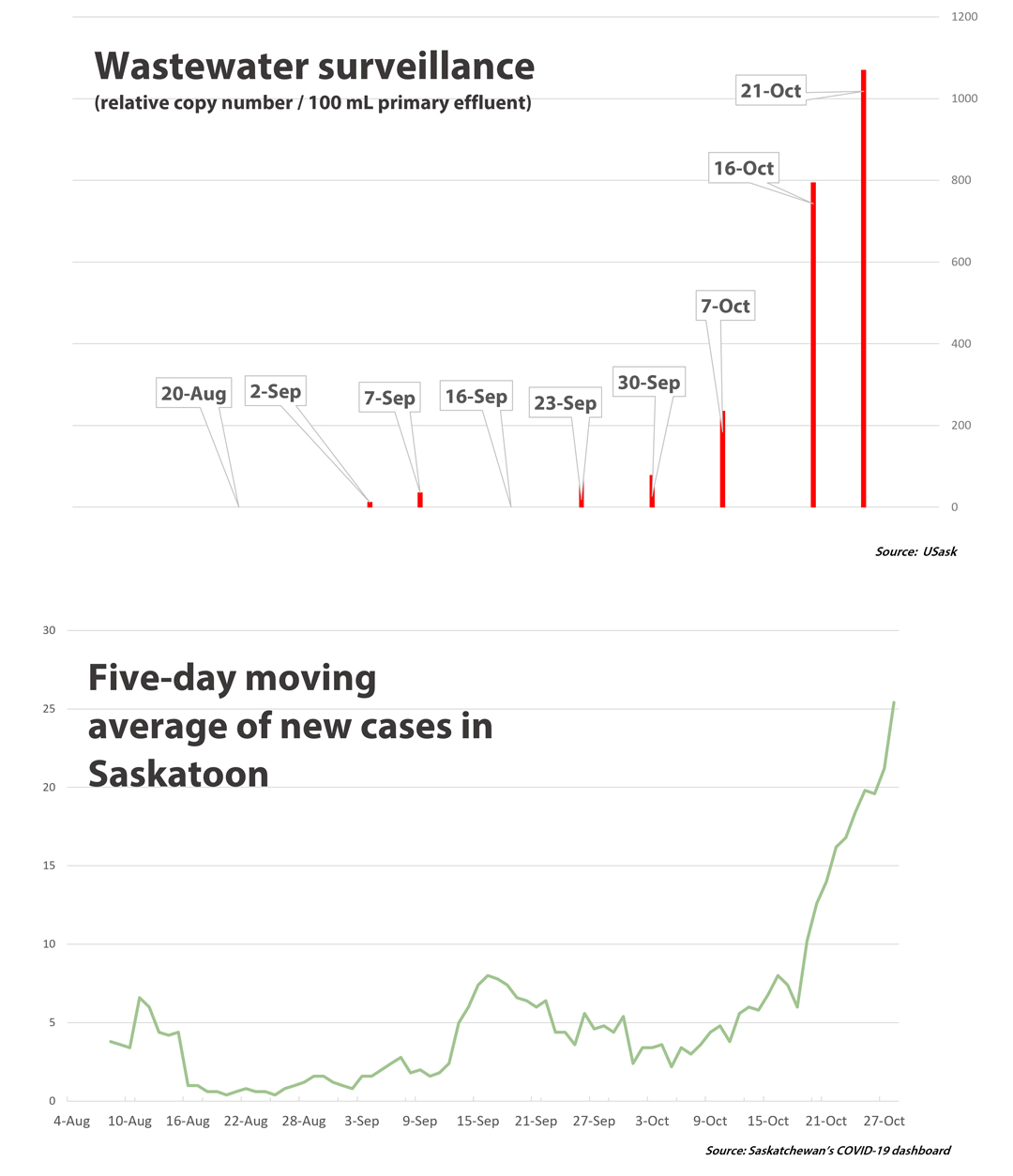
COVID-19 levels in Saskatoon’s wastewater point to upcoming increase in cases
New tool developed at the University of Saskatchewan to detect virus levels
By USask Research Profile and ImpactUniversity of Saskatchewan (USask) researchers and partners at the City of Saskatoon (CoS) and the Saskatchewan Health Authority (SHA) have developed a COVID-19 early warning system by sampling and testing the city’s wastewater for the SARS-CoV-2 virus.
Infected people shed virus traces through their feces, often even before COVID-19 symptoms are apparent. Using a technique developed at USask, the team has found through lab analysis of wastewater samples from Saskatoon’s municipal treatment plant that changes to the total amount of virus circulating in the city’s wastewater happen about one week ahead of changes indicated by case counts at COVID testing centres.
That’s because people who show up at COVID-19 testing stations are usually people with either symptoms or suspected COVID exposure—which misses most of the so-called asymptomatic or pre-symptomatic cases. And as the most accurate nasal swab is collected 48 hours after the onset of symptoms and testing is not instant, positive test results show the past, not the present.
“We think we can give health officials at least a week’s notice on changes in the trend line,” said USask ecotoxicologist John Giesy. “Based on the latest data which shows the trend line is going up, I am predicting we will see a rise in cases for the next couple of weeks. We can also predict when outbreaks are declining, which will help planning for pandemic recovery.”
At present, the team can only predict the trend in COVID cases—up or down, but not specifics on how big a rise or fall in cases there might be.
“It’s really about comparing trends in test cases with wastewater virus concentrations,” said USask toxicologist Markus Brinkmann. “If the virus concentration in the wastewater swings up before we see an increase in COVID test cases, we would expect the curve of the test cases to increase in the upcoming week. Over the past two weeks, we have seen an exponential increase in virus copies in the wastewater.”
The team’s wastewater surveillance approach is based on a method for measuring SARS-CoV-2 virus environmental degradation developed by Giesy and Yuwei Xie. Working with USask engineering researcher Kerry McPhedran, the team has adapted the method to capture COVID-19 information. Engineering graduate student Shahab Minaei and his supervisor Jafar Soltan are also part of the team.
Monitoring of the prevalence of the SARS-CoV-2 virus in Saskatoon’s wastewater began in July. At the city’s wastewater treatment plant, samples are automatically collected over a 24-hour period and pumped into a refrigerator to preserve the quality of the sample. Before the wastewater is released into the environment, it is treated with UV lights, neutralizing any potential infective virus.
The sample is then brought to labs on campus where Xie undertakes a two- to three-day analysis of the purified wastewater. Xie counts the number of copies of an RNA sequence specific to SARS-CoV-2 to establish a total concentration of virus in the sample.
“We can anticipate the rate of change in cases so that public health measures can be implemented in response,” said Brinkmann. “Epidemiologists get more accurate information about prevalence and health officials get a jump-start on allocating resources effectively.”
The research team produces data once per week, and then shares it with the CoS which conveys it to the the SHA.
“The SHA is pleased to be a partner since the inception of this research project, and this is another tool in our surveillance system kit to assist the health system in making decisions on where to focus efforts,” said Dr. Simon Kapaj, SHA’s medical health officer of environmental public health. “The early findings are shaping the public health response in Saskatoon and we believe this tool could assist other major cities in Saskatchewan.”

The research is currently funded by the USask-led Global Water Futures program (supported by the Canada First Research Excellence Fund) through a project originally intended to measure environmental contaminants and which pivoted to focus on COVID-19 research. The work is also supported by in-kind contributions of equipment and personnel from the CofS.
“The City of Saskatoon is pleased to have formed this partnership with the University of Saskatchewan team and the Saskatchewan Health Authority to help understand the prevalence of COVID-19 in the community,” said Mike Sadowski, CoS wastewater treatment plant manager.
Brinkmann said the research team hopes to expand their partnership with CofS and the SHA to provide more frequent estimates (three times per week) and expand to more cities in Saskatchewan.
“Right now, we’re limited in what data we can produce,” said Brinkmann. “If we had dedicated funding for this, we could increase the frequency of gathering and analyzing samples to three times a week, giving us more detailed information with which to perform a statistical analysis for potentially predicting new case numbers.”
The USask approach has been validated by reliability testing organized by the Canadian Water Network (CWN)—a non-profit organization created in 2001 after the Walkerton, Ont. water contamination crisis. Using a set of samples with known concentrations of the virus, laboratories across Canada compared different methods of analysis, and found the USask-developed method was accurate in detecting the virus at different concentrations. Giesy is a member of the CWN advisory panel which also includes virologists, epidemiologists and engineers.
Research into wastewater surveillance is underway in several places in the world. The USask method is also being used by institutions in Ontario, Texas and China.

